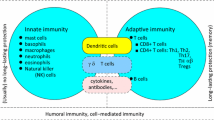Abstract
In order to understand the integrated behavior of the immune system, there is no alternative to mathematical modeling. In addition, the advent of experimental tools such as gene arrays and proteomics poses new challenges to immunologists who are now faced with more information than can be readily incorporated into existing paradigms of immunity. We review here our ongoing efforts to develop mathematical models of immune responses to infectious disease, highlight a new modeling approach that is more accessible to immunologists, and describe new ways to analyze microarray data. These are collaborative studies between experimental immunologists, mathematicians, and computer scientists.
Similar content being viewed by others
References
Morel PA: Mathematical modeling of immunological reactions. Frontiers Biosci 1988;3:338–347.
Burke MA, Morel BF, Oriss TB, Bray J, McCarthy SA, Morel PA: Modeling the proliferative response of T cells to IL-2 and IL-4. Cell Immunol 1997;178:42–52.
Morel BF, Burke MA, Kalagnanam JR, McCarthy SA, Tweardy DJ, Morel PA. Making sense of the combined effect of interleukin-2 and interleukin-4 on lymphocytes using a mathematical model. Bull Mathemat Biol 1996;58:569–594.
Fernandez-Botran R, Sanders VM, Mosmann TR, Vitetta ES: Lymphokine-mediated regulation of the proliferative response of clones of T helper 1 and T helper 2 cells. J Exp Med 1988;168:543–558.
Tufariello JM, Chan J, Flynn JL: Latent tuberculosis: mechanisms of host and bacillus that contribute to persistent infection. Lancet Infect Dis 2003;3: 578–590.
Flynn JL, Chan J: Immunology of tuberculosis. Ann Rev Immunol 2001;19:93–129.
Gammack D, Doering CR, Kirschner DE: Macrophage response to Mycobacterium tuberculosis infection. J Math Biol 2004;48:218–242.
Marino S, Kirschner DE: The human immune response to Mycobacterium tuberculosis in lung and lymph node. J Theor Biol 2004;227:463–486.
Marino S, Pawar S, Fuller CL, Reinhart TA, Flynn JL, Kirschner DE: Dendritic cell trafficking and antigen presentation in the human immune response to Mycobacterium tuberculosis. J Immunol 2004;173: 494–506.
Segovia-Juarez JL, Ganguli S, Kirschner D: Identifying control mechanisms of granuloma formation during M. tuberculosis infection using an agent-based model. J Theor Biol 2004;231:357–376.
Sud D, Bigbee C, Flynn JL, Kirschner DE: Contribution of CD8+ T cells to control of Mycobacterium tuberculosis infection. J Immunol 2006;176:4296–4314.
Wigginton JE, Kirschner D: A model to predict cellmediated immune regulatory mechanisms during human infection with Mycobacterium tuberculosis. J Immunol 2001;166:1951–1967.
Stenger S, Hanson DA, Teitelbaum R, et al: An antimicrobial activity of cytolytic T cells mediated by granulysin. Science 1998;282:121–125.
Lazarevic V, Nolt D, Flynn JL: Long-term control of Mycobacterium tuberculosis infection is mediated by dynamic immune responses. J Immunol 2005;175: 1107–1117.
Boldrick JC, Alizadeh AA, Diehn M, et al: Stereotyped and specific gene expression programs in human innate immune responses to bacteria. Proc Natl Acad Sci USA 2002;99:972–977.
Corcoran DL, Feingold E, Dominick J, et al.: Footer: a quantitative comparative genomics method for efficient recognition of cis-regulatory elements. Genome Res 2005;15:840–847.
Delerive P, De Bosscher K, Besnard S, et al.: Peroxisome proliferator-activated receptor alpha negatively regulates the vascular inflammatory gene response by negative cross-talk with transcription factors NF-kappa B and AP1. J Biol Chem 1999;274:32048–32054.
Author information
Authors and Affiliations
Rights and permissions
About this article
Cite this article
Morel, P.A., Ta'asan, S., Morel, B.F. et al. New insights into mathematical modeling of the immune system. Immunol Res 36, 157–165 (2006). https://doi.org/10.1385/IR:36:1:157
Issue Date:
DOI: https://doi.org/10.1385/IR:36:1:157




